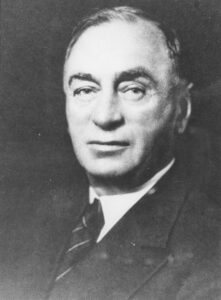Samuel Zemurray
Samuel Zemurray was key to creating a global banana industry that generated great wealth, often at the expense of Latin American laborers, democracy, and economic development.

The Historic New Orleans Collection
Samuel Zemurray began selling bananas at age eighteen in 1895, and later became president of United Fruit Company.
Samuel Zemurray entered the emerging banana industry as a young immigrant entrepreneur and later became the controlling owner and president of the United Fruit Company—today Chiquita Brands International. Born in 1877 in what was then the Russian Empire, Zemurray arrived penniless in the United States in 1891 at the age of fourteen. He became one of the richest men in the world, dying almost seventy years later in a stately mansion on St. Charles Avenue in New Orleans (which now serves as the official residence for presidents of Tulane University).
Zemurray built an empire based on bananas, a process that transformed much of Latin America while stimulating migration, particularly from Honduras, to Louisiana and the United States more broadly. To deliver vast quantities of bananas to American consumers, the industrial agriculture model he helped develop required turning vast swaths of land into massive plantations; building towns, ports, and an extensive network of railroads; manipulating and corrupting governments throughout the region; bringing thousands of people from around the world into banana-producing regions; and exploiting hundreds of thousands of workers who labored for little under difficult working and living conditions. Zemurray achieved great success, but it came at a price for Latin America.
Zemurray got his start in Mobile, Alabama, where in 1895 he latched onto the idea of buying cheap bananas that were on the verge of going bad and quickly selling them in surrounding markets. By the age of twenty-one, Zemurray—now known as “Sam the Banana Man”—achieved considerable success and soon after signed a contract with industry giant United Fruit to buy and sell its ripest fruit.
By 1905 Zemurray moved to New Orleans and acquired several companies, including the Cuyamal Fruit Company, a significant importer of bananas from Central America. Within five years he bought large quantities of land in Honduras and established his own plantations. Zemurray’s tactics resembled those of the other “banana men” of the period, though he was particularly tenacious. In 1911–1912, for example, he helped orchestrate a successful coup in Honduras—in part by hiring New Orleans–based mercenaries—that helped install a government that gave him favorable tax and land concessions. Such actions undermined democracy while at the same time contributed to the continued development of an economy defined by the unequal distribution of land and resources. These political machinations were accompanied by the harsh day-to-day treatment of workers who labored and lived under rough conditions, often suffering (and dying) from malaria and yellow fever as they removed dense jungle to clear the way for railroads, plantations, and all the infrastructure that went with them.
Zemurray continued to expand Cuyamel through the first decades of the twentieth century, becoming a significant competitor of United Fruit, a company whose success depended on acquiring or destroying its competitors. The Cuyamel-United Fruit rivalry became so intense, and on the verge of violence, that the US government facilitated a merger of the two companies. The merger left Zemurray one of the richest men in the world but without a business. Like it had done to so many other competitors, United Fruit swallowed Zemurray’s company.
During his two-year “retirement,” Zemurray’s roots in Louisiana deepened, as he remodeled his New Orleans mansion and bought a twenty-five-thousand-acre plantation in Hammond. His time away from the banana industry was brief. The Great Depression was not kind to United Fruit, which saw its stock price plummet by almost 90 percent, allowing Zemurray to buy a controlling share of the company that had just bought him out. He led United Fruit for the next quarter century.
Now in charge of the largest banana company in the world, Zemurray took United Fruit to new heights, purchasing more land while moving operations beyond Central America into countries like Ecuador and Colombia. Zemurray continued with the same heavy-handed tactics that put him on top. Perhaps most infamously he helped orchestrate the 1954 coup to overthrow President Arbenz, a democratically elected president of Guatemala who once threatened to expropriate lands owned by United Fruit. Arbenz’s overthrow began a decades-long period defined by dictatorship, civil war, and genocide in Guatemala.
After retiring from the banana business in the mid-1950s, Zemurray dedicated a significant amount of the money he acquired by exploiting plantation workers in Latin America to philanthropic causes in New Orleans and beyond. Several New Orleans institutions, such as the Touro Infirmary and Tulane University, benefitted from his generosity. The latter received not only large quantities of money and his St. Charles Avenue mansion but also Mayan artifacts that had been removed from United Fruit plantations over the decades.
